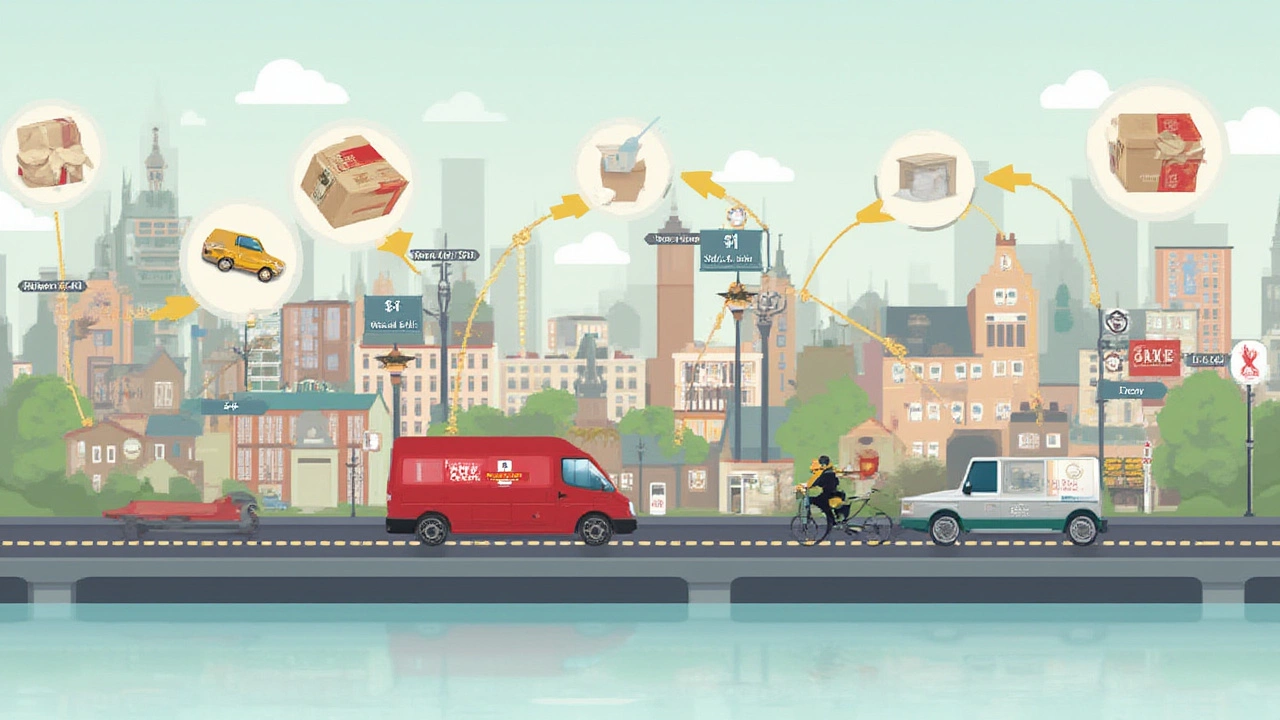What if shipping your next parcel didn't cost as much as you thought? Courier and mail options go head-to-head at every New Zealand post office and courier depot, but while people swap stories about wild price differences, the reality is way more interesting than 'courier is always more' or 'NZ Post is cheaper for everything.' Whether you're moving a single birthday card or a mountain of eBay sales, knowing when and why one choice wins could keep a few more dollars in your pocket. Stick around, because the true winner isn't always as obvious as you think.
How Courier and Mail Pricing Actually Work
So, where does the money go when you send a package? Both couriers and standard mail have their formulas. Here in New Zealand, mail usually means traditional postal services like NZ Post, handling letters, small parcels, and tracked envelopes. Couriers, on the other hand, range from familiar names like NZ Couriers and Fastway to international players such as DHL, FedEx, and Aramex. They focus on speed, tracking, and door-to-door convenience, but price depends on more than just the badge on the courier driver's uniform.
You might assume regular mail is always cheapest, especially for envelopes or very light parcels. Most of the time, that's true—sending a regular letter anywhere in NZ costs just a couple of dollars, and a tracked small parcel under 3kg can be sent for under $10 with the right packaging. Couriers start at around $7 for ultra-light, prepaid options but quickly climb to $15-40 for bigger or heavier stuff. The wild thing is, once your parcel creeps over certain size or weight thresholds, mail costs can leap almost overnight, sometimes making courier not only speedier, but also cheaper.
What really drives the price up? Heavier packages (especially above 3kg) or awkward shapes are the classic culprits. NZ Post applies volumetric pricing: massive soft toys can end up pricier than a 5kg box of books. Couriers do this too, but some courier services offer more generous thresholds or fixed-rate satchels if your item physically fits, even if it's dense. Then there's destination. Rural addresses add extra fees for both mail and couriers, but you'll find some couriers can undercut the extra rural fee, especially if the company has its own local depot or if they're running specific rural promotions.
Not everything is about the label though. Factor in how you send—are you dropping it off, or does someone need to pick up? Most couriers charge for door-to-door, while mail can be self-dropped at hundreds of locations. But if you want tracking, insurance, or Saturday delivery, those features add up with standard mail, sometimes matching courier quotes.
| Item | Mail (NZ Post) | Courier |
|---|---|---|
| Standard letter | $2.00 | $7.00+ |
| Tracked small parcel (NZ-Auckland, under 3kg) | $8.00 | $8.50 (prepaid bag) |
| Large parcel (4kg, North to South Island) | $23.00 | $19.99 (satchel, fits size) |
| Rural surcharge | $4.80 | $4-7 |
| International letter (to AUS) | $3.30 | $30.00+ |
Another factor? Extra services. Let’s say you want signature on delivery or want to insure your $500 tablet that you're shipping to Christchurch. Standard mail stacks up optional extras, bumping the price $4-10, while plenty of couriers include tracking or basic insurance free in some tiers. Also, commercial senders usually get sweet discounts with both mail and courier companies, meaning bulk-shippers almost always get cheaper rates per item. If you’re selling on TradeMe or Shopify, ask about business deals—sometimes couriers beat mail by a mile on volume alone.
Here's a tip: all major services including NZ Post, CourierPost, or Aramex publish their rates and have calculators online. Plug in your exact size, weight, and destination... you might be shocked how often the "right" option flips with just a few centimetres or grams.

When Is Each Option Cheaper? Real Scenarios in New Zealand
People love rules of thumb, but actual savings can feel like a moving target. Let's crack open some real-world situations so you can skip the guesswork and pick the winner for your next delivery.
If you’re mailing a birthday card or a compact, lightweight item like an earbud case, regular mail is almost unbeatable on price—especially if tracking or speed isn’t urgent. A letter to Queenstown or Hamilton is flat-rate around $2. Add tracked upgrade, and you’re still under $5. Couriers rarely beat this unless they’re running promo rates or you’re stacking up for bulk business shipping.
The story changes with bulky, heavier stuff. Take a 5kg parcel heading from Auckland to Wellington. Standard mail through NZ Post hits about $23 (as of last year), but courier companies like NZ Couriers, Post Haste, and Aramex offer prepaid bags for around $18-22 if your box can fit. Toss in rural delivery? Both add similar surcharges, though couriers sometimes cap this or make deals with local runs.
International parcels are a different game. A letter or skinny document to Australia—mail wins with prices under $5. But if you're selling a $500 sneaker or a bulky gift, courier services, despite the higher base rate, often blast through customs way quicker, offer decent tracking and can sometimes undercut premium airmail for mid-weight parcels. You can also snag discounted off-peak rates if you’re not picky about delivery timeframes.
Then there’s the business side—bulk senders: online shops, subscription boxes, or people flipping finds on marketplace sites. Here, couriers are famous for aggressive pricing if you ship dozens or hundreds a month, sometimes offering 20-40% off rack rates. Mail does have business deals, but not as many low flat-rate satchel options. For tiny businesses just starting out? Combine both. Use mail for single, light orders, and a courier account for bigger regular sales where you can haggle or bulk-buy parcel bags.
Speed wins tie-breakers. If you need overnight or next-day delivery, couriers dominate New Zealand’s main centres for service—and plenty even deliver Saturdays, compared to mail’s Monday-to-Friday grind. Sure, it costs more, but occasionally the faster courier bag is virtually the same price as priority mail, especially for large envelopes or light parcels. Pro tip: sign up for email promos from local courier companies, because they often run seasonal deals at rates that make even NZ Post blush.
What about surprise fees? Always check the fine print. Mail can stack up extras for oversize items, custom shapes, or insurance, while couriers might add pickup fees or fuel levies. Weigh and measure everything—those few grams or centimetres could save you $10 easily either way. Don’t forget to try your Eftpos loyalty cards—supermarket or petrol chains sometimes give parcel pickup discounts if you use their satellite drop-off counters.

Secret Ways to Save—Beyond Just Price
Turns out, hidden value goes way beyond the sticker price. Let me give you the rundown on fees, perks, and smart hacks that Kiwi senders use daily to make post vs courier really pay off.
First, think reliability. No one wants a package ending up in Whangarei when it’s meant for Wellington. Couriers are famous for better tracking and handling here in New Zealand. You can follow a parcel online in real time, and signature-on-delivery is often included or just a couple extra bucks. Standard mail? Tracking is an add-on; it works, but it’s not always as instant or detailed. And if a parcel goes missing, claims through most courier companies are faster compared to wrangling with general post insurance. Sellers who care about buyer feedback often bite the courier cost for peace of mind.
Second, packaging can make or break your price. Courier companies love prepaid satchels—if your item fits, you just pay the bag’s fixed fee regardless of weight (up to the stated max, of course). This is a goldmine for heavy stuff in compact packaging. Mail usually charges based on a mix of weight and size, so you can pay more for pillows than for dumbbells. If you ship heavy tools, books, or tech, squish and wrap tightly to fit those courier bags to max out the value.
Third, use trade accounts or loyalty programs, even if you’re just a regular person shipping more than once a month. Most couriers drop rates for repeat senders, and some even have points or stamp cards. Retailers who plug into Shopify, Trade Me, or Etsy can add shipping integrations at checkout, automatically fetching the best courier rates and offering your customers live tracking. In 2024, Shopify reported that over 60% of NZ online shops switched to hybrid models—mixing mail and courier by price and destination—and their customer service gripes dropped by a third, just because deliveries became more predictable.
When to skip the courier? If you’re sending documents or flat things that absolutely, positively don’t need urgent arrival, plain mail still wins (think passport renewals, basic legal documents, or personal cards). Also, remote or offshore islands often don’t have great courier coverage, so standard mail can be both cheaper and more available. For international e-commerce, major couriers like DHL and FedEx crush postal timeframes, but only for higher-value, time-sensitive deliveries. For small under-$50 orders, mailing via NZ Post keeps you legal with customs and way cheaper for recipients in places like Australia or the Pacific Islands.
Instead of gambling, try this three-step hack before sending anything: 1) Weigh and measure every parcel accurately; 2) Use the online calculators for at least two providers; 3) Factor in extras like rural delivery or urgent fees—and don’t forget insurance if it matters to you or your buyers. For popular NZ send-off spots like Auckland, Wellington, or Christchurch, Google Maps even shows real-time drop-off and pickup times for couriers versus mailboxes.
Finally, always check if you qualify for special rates. Are you a student, a nonprofit, or a club volunteer? Several courier and mail companies run quiet discounts if you show a student card or are posting gear for registered charities. And don’t ignore third-party resellers—places like Trade Tested, PackSend, or Shipmate sometimes beat standard rates for both mail and courier because of their buying power.
The key thing? Price isn’t everything. Safety, tracking, and speed are huge, but with good prep, handy calculators, and some clever packaging, you’ll get the best deal—no matter which logo is on the shipping label. And now, next time someone at the post office mutters, “Courier’s always more expensive,” you’ll know when to nod, and when to raise your eyebrow.





